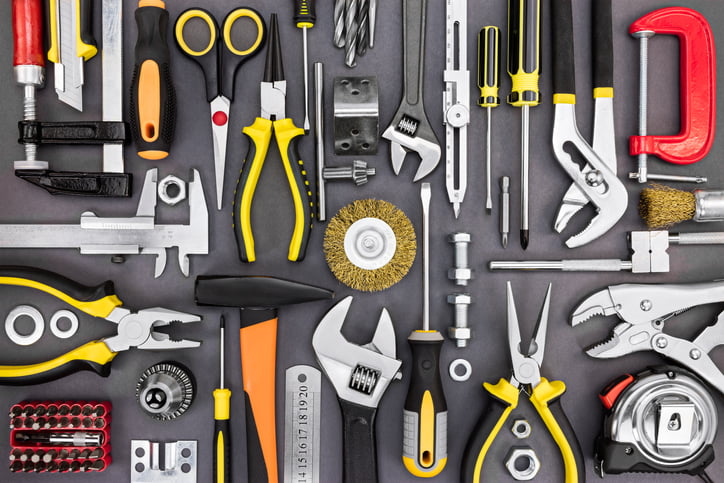Hand tools offer great utility when it comes to construction, repair and demolition. However, they can also be quite hazardous. Fortunately, there are many precautions workers can take to save themselves and their colleagues from hand tool hazards.
As the name suggests, a hand tool is something that is directed by a human hand instead of a motor. Hand tools are mostly used when space is not much and the access is also difficult.
Cutters, pliers, wrenches, saws, and drills, are some of the examples of hand tools. Inappropriate use of these tools results in various types of hazards such as bruises, cuts, and lacerations.
Hand Tool Hazards And Preventions
Using hand tools for a long period of time can take a toll on a human body and cause aches, soreness, fatigue, and pains. These problems, when ignored, result in musculoskeletal injuries of various kinds: tendonitis, bursitis, epicondylitis, tenosynovitis, etc.
Some people might injure their hands or end up cutting their fingers while inappropriately using certain tools. Severe vibrational equipment also affects our neurons.
For these reasons, workers take part in hand tool safety courses to protect themselves from injuries and physical issues. However, even if someone does work a blue collar job, it’s important to know about the hazards of hand tools.
Common Hand Tool Hazards
Several working ways and conditions of tools can cause hazards. They are discussed as under.

1. Uniform load on upper body and arms muscles
Uniform load often happens when muscles of a body part are not moved for a longer time period. This posture is undesirable and uncomfortable when practiced in the working area. This static posture restricts blood flow to the affected muscles, increasing the risk of discomfort and potential long-term health issues.
2. Uncomfortable body postures and working positions
While using a hand tool, one needs to focus on the proper position and handling of a hand tool. If a hand tool is used improperly it will result in an injury. Workers often dropped heavy tools on their legs due to being in awkward positions. These strained positions can also lead to muscle fatigue, discomfort, and even musculoskeletal disorders over time.
3. Tissue compression due to strong grip
The hand tool requires a strong grip. If tissues of the holding area become compressed or static, it may disturb blood circulation which will result in tingling and numbness. Blisters are a common result of such hazards. In addition to tingling, numbness, and blisters, prolonged compression of tissues while using hand tools can also lead to a reduced range of motion and, in some cases, long-term nerve damage
4. Constant vibration in a part of the body
Some heavy hand tools such as chipping hammers may produce strong vibrations which are responsible for the hand-arm vibration syndrome (HAVS) also known as white finger or Raynaud’s syndrome. Symptoms of HAVS include not only the characteristic white or bluish fingers but also a loss of dexterity, numbness, and a tingling sensation in the fingers. This makes it a significant occupational health concern.
Common Accidents With Hand Tools
Unfortunately, accidents with hand tools are all too common. Here are the risk you face while working with these tools.
- While using the chisel as a screwdriver, the tip of the chisel might break and fly off, hitting the user or any other employee.
- The wooden handle on a tool, like a hammer or an ax, is cracked or loose, the head of the tool might fly off and hit the user or any other employee.
- Sprung jaws of the wrench may also cause hazards.
- Eye injuries can also cause the projection of particles or fragments.
- Sprains or strains due to abrupt movement also cause hazards.
- Slipping while using a hand tool which will cause a real injury.
Precautions Of Hand Tool Hazards

How can a person protect himself from hand tool injuries and hazards? Have a look at the list below.
Employees need to understand that the employer is the one who is responsible for the perfect condition of equipment and tools which are used by employees. The employer should grant permission for the usage of tools that are not perfectly fine or have some doubted conditions.
- Use quality and suited tools according to the work.
- Users should have proper knowledge of tools.
- Focus on risk assessment.
- Use tools that have insulating covering.
- Use protective goggles when there is the risk of fragmented particles.
- Wear gloves while handling sharp tools.
- Never use a tool if you don’t have complete knowledge about it.
- Check the reliability of tools from time to time.
- Adopt a defensive behavior while using hand tools.
- Keep your mind completely on the task at hand.
- Protect your hands at all costs while using manual tools.
- Keep hand tools in tool bags, suitable panels, or in dedicated boxes.
- Keep sharp objectives away from the close proximity of other employees.
- Sharp tools are safer than dull ones; keep scissors and knives sharp.
- Keep work floors dry and clean to prevent slips while using hand tools.
- Use spark-resistant tools made from aluminum and brass near fire or flammables.
- Tools should be heat treated.
- The metal area of the hand tool should have no traces of rust on it.
- Tools have to be in very good condition.
- Hand tools must be replaced from time to time.
- There should be no fractured or broken tools or handles.
- Files should be used with extra care as they are sharpened from both sides.
- Inform employees about hand tool hazards and their precautions.
- Face shields, safety glasses, and gloves should be worn while using hand tools.
- Teach perfect body posture while using hand tools.
- There should be no loose tools.
- Keep tools in secure and dry locations.
- Examine tools before using them.
- On the first attempt, always operate the tool as guided by the manufacturer.
- Inspect tools regularly.
- Don’t try to use tools for different kinds of works but for the ones they are made for.
- Grind and sharpen tools from time to time.
- Never carry pointed tools in pockets.
- Never use hand tools in a hurry as it will cause hazards.
- Avoid loose clothing in which tools can get caught.
- Avoid slippery footwear.
- Focus on the perfect direction of your foot and hand to use tools safely.
- Never pick up a falling immediately or catch it mid air
- Stay alert and protect the people around you from the hand tools.
- Never hold tools in hand while climbing a ladder, use a bag or a bucket instead.
- While working on heights, do not leave tools from where they could fall on others.
- Report about damaged tools to the supervisor.
- Keep an extra tool with you in case of emergencies.
Protect Yourself And Others Hand Tool Hazards
While working with hand tools, always keep in mind that users’ safety is extremely important but along with that, the other people working with the use also matter and their safety is important too. Never take a step to challenge other people’s safety. Safely work in collaboration with others.
Enrolling in OSHA 10-Hour construction and a more comprehensive, OSHA 30-Hour construction would help you stay safe from hand tool accidents and other hazards at the workplace.



